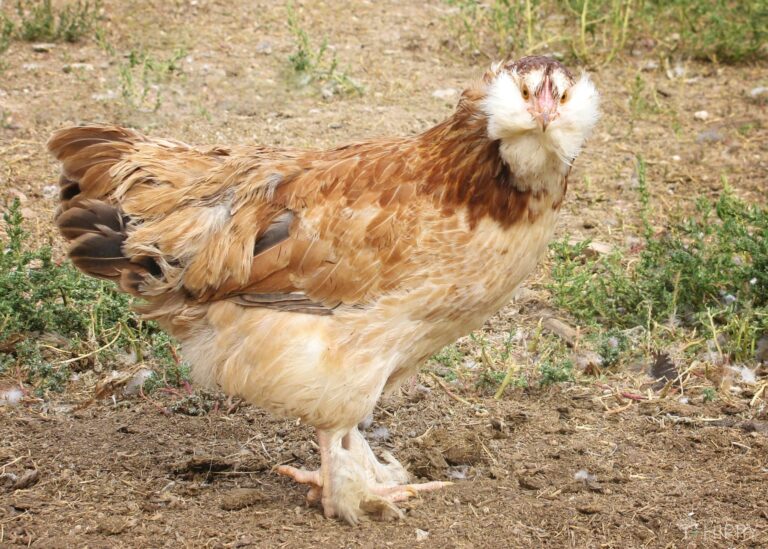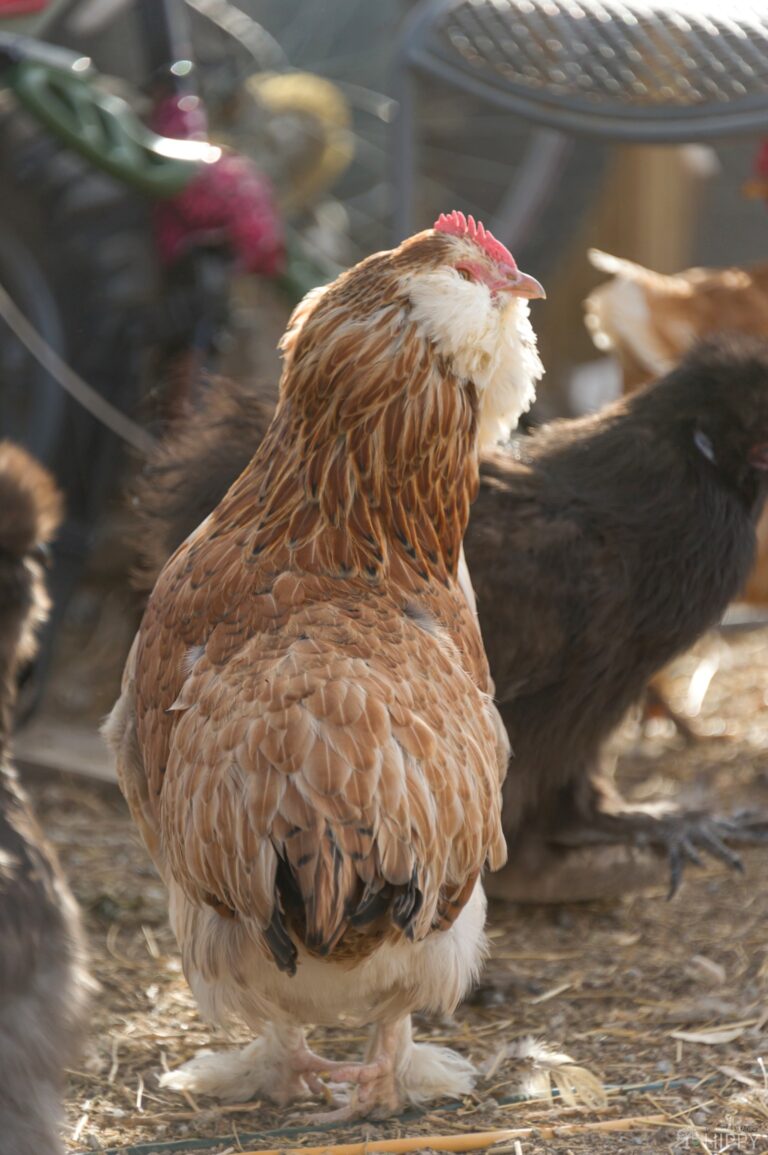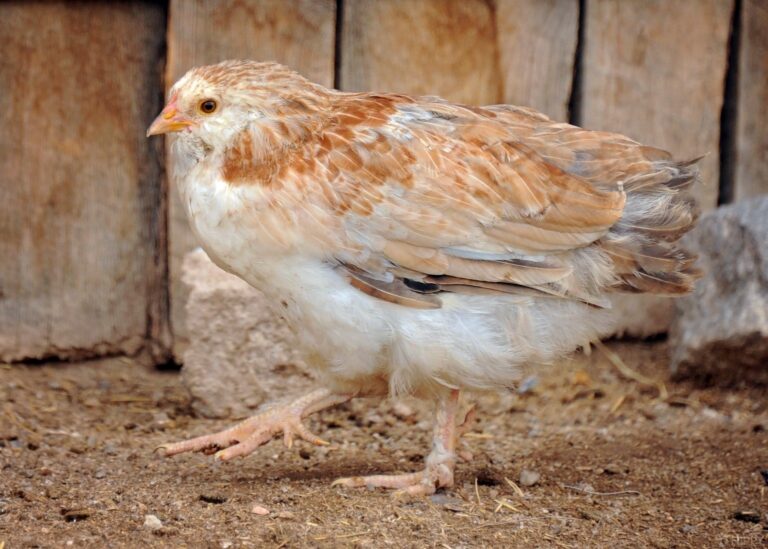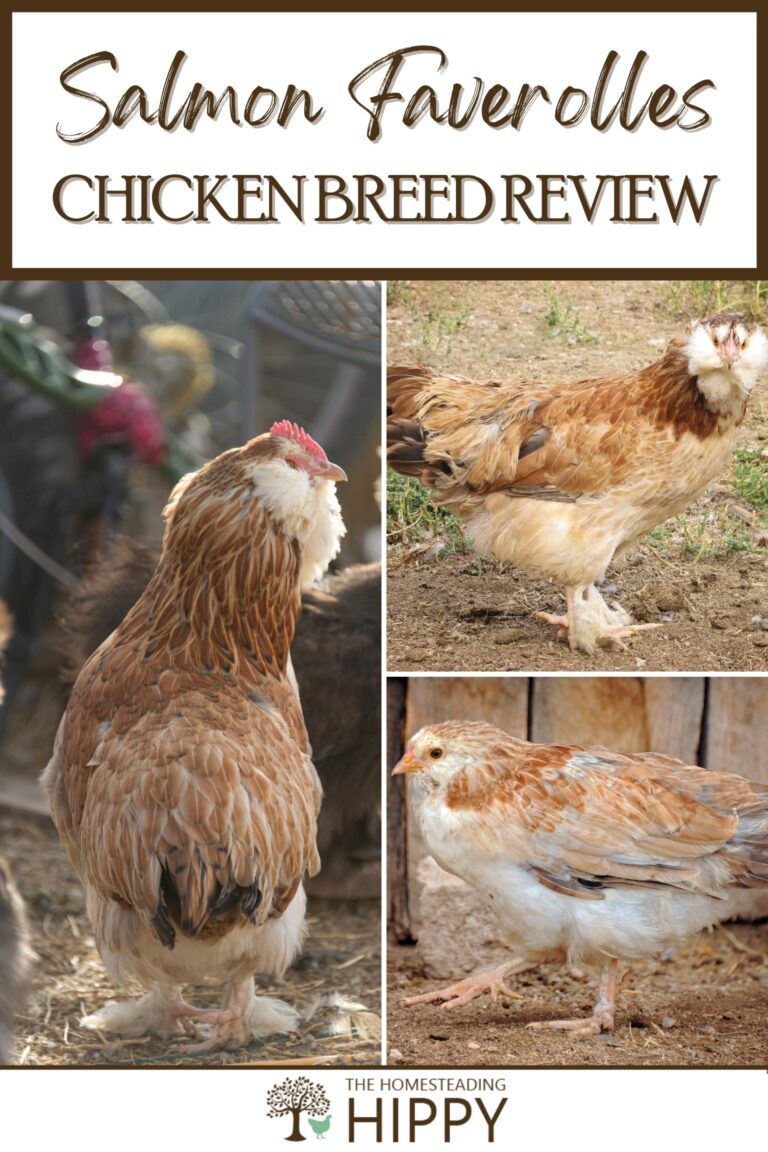One of the best things about keeping chickens is seeing all the different breeds that are out there. Seeing all of the varieties and all the differences in their physicality and temperament is a hobby unto itself.

One of the most interesting heritage breeds is the Faverolle, hailing from France. Originally kept as an egg producer and also for meat production, today they are an exhibition breed that is also popular as pets among keepers, thanks to a combination of quietness, friendliness and docility.
You will rarely find a chicken that’s so beautiful that is also so tame, and sometimes tame to a fault! I’ll tell you everything you need to know about the Salmon Faverolle below…
Salmon Faverolle Quick Facts
- Purpose: Exhibition, formerly dual use with focus on egg laying.
- Plumage: Salmon, a combination of black, brown and straw or ivory feathers. Other colors include white, black, and blue.
- Eggs Laid Year on Average: 150-200.
- Egg Color: Light brown, tan, pink.
- Broodiness: Moderate.
- Average Weight: 10 ½ pounds, roosters. Hens average 9 pounds.
- Average Height: 24″
- Lifespan: 5 to 7 years.
- Temperament: Extremely docile and friendly. So passive they are prone to being bullied by other chickens.
See more facts.
What Color and Pattern are Salmon Faverolle Chickens?
The Salmon Faverolle, somewhat contrary to what the name would suggest, is actually a combination of colors, particularly straw or ivory with alternating patches of black, brown and speckled feathers in roosters, wild females tend to be a medium brown and ivory.
This creates a really striking appearance, and in conjunction with the muffs and beards of this breed, a particularly photogenic bird.
However, other colors are common, including the usual all white and all black along with mahogany, splash, cuckoo, blue and ermine.
Salmon Faverolle Essential Characteristics
The Salmon Faverolle is today an exhibition bird, the one that is also still kept for its original utility purpose of providing meat and eggs.
These striking chickens originate from France, first developed in the mid-19th century near the village of Faverolles from which they derive their name.
Although relatively recent compared to some other heritage breeds, several other well-known domestic chickens were used in their development, including the Dorking, Brahma, Crevecoeur and potentially the Cochin.
The result was a large, hardy and vital breed, heavily feathered, and also one that featured fluffy beards and muffs to complement their striking coloration.
This heavy feathering along with their overall good health has made them ideally suited for cold weather, and hens as a rule will lay right through the winter most times.
Speaking of, the Faverolle is a chicken that is a dependable and steady egg layer whether or not it is allowed to free range or forced into confinement.
One historical note reports that these chickens, more than any of their contemporaries, tolerated the cramped confines of being housed in battery cages for egg production.
Hopefully you won’t be keeping your Faverolles in battery cages, but the breed today has maintained this famous adaptability and has also kept its wonderfully easy-going attitude.
As long as they are well cared for and not distressed, Faverolles are still excellent egg layers, and also a preferred pet chicken for children and adults alike since they are famously patient and gentle.
Another interesting characteristic is that this breed does not typically vocalize very much and its vocalizations are quieter compared to most other breeds. Perfect for backyard keepers if you have grumpy neighbors or noise ordinances in effect!
What are Salmon Faverolle Chickens Raised For?
Today, the Salmon Faverolle is mostly an exhibition breed, bread to keep this heritage chicken alive in the public consciousness and also for the admiration of their truly marvelous posture and plumage.
However, more than most other breeds the Faverolle is still a dependably good dual-use chicken. They’re more than capable of producing plenty of eggs, and also make good table birds.
And, as mentioned, they are truly fantastic pets, and there are precious few other domestic breeds that are as friendly and as agreeable as they are.
How Big are Salmon Faverolles?
The Salmon Faverolle is a large breed. Roosters average about 10 and a half pounds, while hens are only a little bit lighter at about 9 pounds.
These are heavily built, stocky chickens, with broad bodies they’re shaped almost like a blunt bell, what is called a “trapezoid” shape.
Along with their heavy feathering, this makes these chickens look significantly heavier than they really are, though they definitely belong in the large breed class.

Are Salmon Faverolle Chickens Good Layers?
Yes. The Faverolle is a dependably good layer, and hens will average about four eggs a week when in good health, totaling anywhere from 150 to 200 eggs per year. Hens will typically lay straight through the winter.
Also, hens are not known to be particularly broody, but it does happen so make it a point to collect eggs regularly if you don’t want mom to try and hatch them.
What Color Eggs Do Salmon Faverolles Typically Lay?
The Salmon Faverolle is notable for laying eggs that are either tan, light brown, or an incredible light pink color. An Easter Egger has nothing on these fantastic French chickens!
When Do Salmon Faverolles Start Laying?
Faverolles mature pretty quickly compared to other breeds, and you can usually depend on hens to start laying right around 20 weeks old, or perhaps a little bit after.
What Do Salmon Faverolle Chickens Eat?
Salmon Faverolles are very enthusiastic free-ranging chickens, and notably chicks will begin to free-range as soon as they begin to mature.
They of course love to eat all the things that other chickens eat, including bugs, worms, snails, slugs and other tiny creatures, along with all sorts of plant matter.
Something else to keep in mind is that, despite tolerating confinement very well, Faverolles tend to be very curious explorers when allowed to roam, and they will definitely enjoy larger spaces to explore and hunt through if you’ll allow it.
This is a great way to ensure that your chickens are getting a variety of whole foods in their diet, including a few seeds, grass and other incidental foods.
However, like all domestic chickens, they should subsist primarily on a diet of nutritionally complete chicken feed, supplemented with grit and potentially with micronutrient supplements as required.
No matter how active these birds are when hunting, they will need extra nutrition as they grow and hens in particular when they are laying.
Make sure they get extra food for calories, and don’t hesitate to supplement with calcium if required. But other than this, Salmon Faverolles have no special nutritional requirements…

How Long Do Salmon Faverolle Chickens Typically Live?
Salmon Faverolles are a fairly long-lived bird, with an average lifespan ranging from 5 to 7 years assuming they have no other health issues. This is about standard for large breeds of their size and build.
Are Salmon Faverolles Prone to Particular Health Issues?
No, not many. For a heritage breed, the Salmon Faverolle is particularly healthy, vital and downright robust.
These birds rarely fall victim to common ailments, but they do have one shortcoming when it comes to their health: those fluffy feathers covering their legs, and their beards and muffs, make them highly prone to lice, fleas and other external parasites that can potentially lead to serious health conditions if not spotted.
You’ll have to be very diligent about combing through these thick feathers when inspecting your chickens and looking for any signs of prior or ongoing infestations.
Don’t get lazy, make it a point to check regularly, and you shouldn’t have any difficulty keeping the issue under control.
Typical treatments work just fine, but take care if you’re using any powder or dust products for the purpose: their beards and muffs can keep this dust around their eyes and nostrils too long, potentially causing irritation.
But, once again, a little bit of caution is all that is required to ameliorate this issue.
Are Salmon Faverolle Chickens Friendly?
Yes, and famously so! There are few chicken breeds that are so consistently friendly and docile as the Faverolle.
This makes them wonderful pets for adults or for children, and they are extremely patient and calm even when they are stressed out or injured.
Many keepers have reported that the Salmon Faverolle is among the friendliest chickens they have ever encountered, and this reputation precedes them for a reason.
However, that famous agreeableness with people might lead to trouble with other chickens in mixed flocks. See the next section.
Do Salmon Faverolles Get Along with Other Chickens?
Strictly speaking, yes, Salmon Faverolle chickens will get along just fine with other chickens. They don’t bully, they don’t cause trouble, they don’t start fights as a rule.
But, sadly, these serene birds are so friendly they won’t usually stand up for themselves to other chickens of any kind.
That means they are highly prone to being bullied by more aggressive chickens, or ones that are compelled to climb the dominance hierarchy within a flock.
You cannot depend on your Salmon Faverolle to stand up for itself and reassert order.
For this reason, you should an eye on things of adding them to any mixed flock, and if you want to avoid trouble entirely consider getting a flock consisting of nothing but Faverolles.
What Kind of Chicken Owner are Salmon Faverolles Right For?
Right up front, there are several kinds of keeper that the Salmon Faverolle would be perfect for, and for a number of reasons…
For seasoned keepers or chicken fanciers, the Salmon Faverolle is a stunningly gorgeous, and impressively large chicken, and a heritage breed of significant cultural importance. This makes them a shoo-in for exhibition, show or just personal appreciation.
That iconic salmon plumage is particularly head-turning, though they are indisputably gorgeous in other colors as well.
Their combination of docility, good health and modest lifespans also makes them a wonderful choice for backyard keepers or smaller operations.
You can depend on a Faverolle hen to give you eggs reliably for years, and all year long because they lay through the winter.
They also grow big and develop quickly, and their meat is of good quality, meaning they still work just fine as a table bird. Faverolle capons in particular or said to make an excellent meal.
Remember, even though these chickens are gorgeous today, they were originally developed as a dual-use utility breed, and they have maintained all of those essential characteristics from those many years ago when they were created.
If you want eggs, meat, or both, don’t hesitate to get a Faverolle!
Lastly, if you just want a few chickens as pets or engaging hobby, if you want to teach your children how to handle chickens, or if you are just nervous about dealing with them in general, you could hardly do better than a Faverolle.
Although you might argue that there are some other chickens that are even friendlier, like the Silkie, in my estimation there is no breed it is more consistently friendly, more agreeable to different conditions and more reliably docile than the Faverolle.
So whatever reasons you want a Faverolle, ornamental, production, or just as part of a new and rewarding hobby, they make a wonderful choice and are always easy to handle.
Think twice if you are including them in a mixed flock, particularly if there are known troublemakers or bullies in it, but other than that you won’t have any issues…
Salmon Faverolles FAQ
Faverolle chickens are nominally rare, but surprisingly easy to find because many keepers and breeders are highly enthusiastic about them. Note that the Salmon color is the most common, so if you have your heart set on another kind of plumage you might have to work harder to find them.
No. You’ll usually have to give chicks anywhere from 3 to 5 weeks in order to tell the boys from the girls.

Tim is a farm boy with vast experience on homesteads, and with survival and prepping. He lives a self-reliant lifestyle along with his aging mother in a quiet and very conservative little town in Ohio. He teaches folks about security, prepping and self-sufficiency not just through his witty writing, but also in person.
Find out more about Tim and the rest of the crew here.
